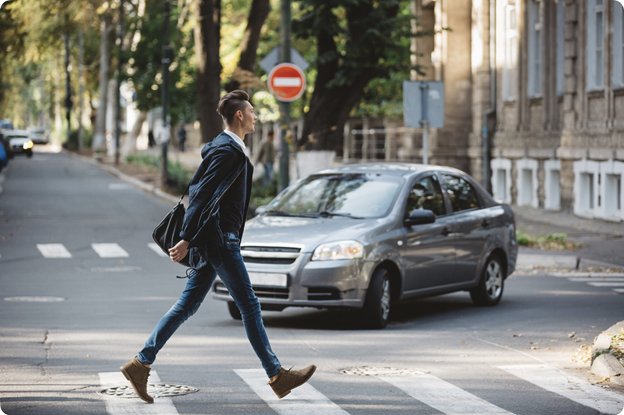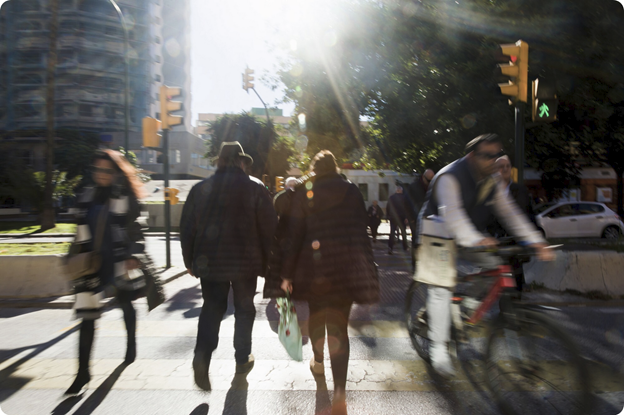Common Causes of Pedestrian Accidents and How to Avoid Them
On average, there are around 722 injury collisions and 13 fatal crashes every year on Niagara roads. Of those, pedestrian accidents account for 13% of all fatal collisions and 9% of injury collisions. The key to staying safe in Nigara Falls starts with understanding where, why, and how these accidents happen.
What Is a Pedestrian Accident?
By definition, a pedestrian accident happens when someone travelling on foot is struck by a motorized vehicle, such as a car, truck, motorcycle, e-bike, or even an e-scooter.
The law recognizes how vulnerable pedestrians are and offers strong legal protections for pedestrians when such accidents occur. Under Section 193(1) of the Highway Traffic Act, there is a legal presumption that the driver is at fault in a pedestrian accident on a public roadway.
In plain language–if you are hit by a vehicle while walking, the law presumes the driver was at fault. This “reverse onus” makes it easier for pedestrians to bring a successful claim. However, drivers can defend themselves by showing that they acted reasonably; for example, by arguing that you walked into traffic unexpectedly.
Where and Why Pedestrian Accidents Happen Most
Certain places in Niagara Falls are more dangerous than others when it comes to pedestrian accidents. It’s not just because of traffic volume, rather because of how drivers and pedestrians behave in those spaces, and the chain of events that led up to the accident.
Intersections: The Most Common Location for Pedestrian Deaths (21%)
More than one in five fatal pedestrian accidents occurred at intersections. These are spots where two or more public roadways meet, or where traffic circulates through a roundabout.
In many of these fatal cases, pedestrians were following the traffic signals. However, drivers either failed to yield, misjudged timing, or turned without checking the crosswalk. Left-hand turns are of particular concern.
Mid-Block Crossings and Non-Intersection Areas (14%)
The second most common locations are mid-block areas where pedestrians try to cross without a marked crosswalk. Typically, these are either unregulated crossings which people use for convenience or when intersections are far apart.
The risks are clear: drivers aren’t expecting people to cross in these areas, lighting is often poor, and speed limits tend to be higher between intersections.
Highways (13%)
Pedestrians on highways are in one of the most dangerous scenarios imaginable. The speed of vehicles is high, and the reaction time of drivers is low. That means whether someone is walking after a breakdown, crossing lanes on foot, or exiting a disabled vehicle, the risk of a pedestrian accident is great.
Note that walking on highways is prohibited in many cases–and with good reason, since accidents can often be fatal.
Parking Lots and Private Property (10%)
Surprisingly, a full 10% of fatal pedestrian accidents in Niagara Falls happen in parking lots or on private property, most of these involve vehicles reversing. Pedestrians (especially children) can be hard to see when backing out of a space. If the area is unlit, it’s even easier for drivers to miss someone walking behind their vehicle.
Railways (8%)
Railway-related pedestrian fatalities are relatively less common, but not negligible in frequency. These accidents usually involve pedestrians trying to cross train tracks at undesignated spots, misjudging the speed or distance of an oncoming train, or ignoring signals. Needless to say, trains cannot slow down quickly, meaning accidents cause catastrophic injuries and fatalities.
Here’s What You Can Do to Avoid Pedestrian Accidents in Niagara Falls
Niagara Falls is high-traffic city with a mix of urban intersections, commercial plazas, residential streets, and rural highways. Add to that the regular influx of out-of-town drivers who are unfamiliar with local roads and may be distracted by GPS devices or road signs, and the risks of pedestrians are even greater.
Here are practical steps you can take to protect yourself when walking in and around Niagara Falls:
Make Sure You Are Easy to Spot Even at Night
Foggy mornings, snowy evenings, and poorly lit suburban streets make visibility a challenge. To be visible to drivers, wear bright or reflective clothing when walking after dusk. If you’re walking in winter or after dark, carry a flashlight or wear a reflective armband.
Always make eye contact with drivers, especially on busier roads like Stanley Avenue or Thorold Stone Road before crossing. Even if you have the right of way at intersections, don’t assume the driver will have seen you.
Avoid Taking Shortcuts if There Are No Marked Crosswalks
Always use marked crosswalks, pedestrian lights, and crossing guards. If no crosswalk is nearby, cross at intersections, where drivers are more likely to anticipate pedestrians. For added safety, consider avoiding crossovers that don’t have flashing warning signals that tell drivers someone is waiting to cross.
Stay Off High-Speed and Rural Roads
The Niagara region includes busy highways as well as semi-rural stretches of roads, where sidewalks may be limited or absent. Avoid walking along these roads whenever possible, especially in winter, when icy shoulders and snowbanks reduce walking space. If you have no choice, walk facing traffic, stay as far from the road as possible.
Stay Alert in Parking Lots and Driveways
To keep yourself and children safe, keep your head up when walking through any lot or laneway. Put away your phone when you’re traversing a parking lot or driveway; if you’re distracted, you may not notice reversing lights or that a driver has started to move. Also, avoid walking directly behind vehicles that are idling or have just parked. Give vehicles space, especially if their headlights or tail lights are on.
Don’t Walk Impaired
It can be tempting to walk home after a few drinks, but 20% of pedestrian fatalities involve alcohol or drugs. Also, the majority of impaired pedestrian accidents occur at night. If possible, call a cab, take public transit, or have someone you trust walk with you.
Also Read: When to Partner with a Personal Injury Lawyer
You Are Entitled to Compensation as a Pedestrian
If you have suffered a pedestrian accident, you are entitled to receive Statutory Accident Benefits, even if you don’t have insurance. These can cover your medical costs, provide income replacement, attendant care, and more.
Book a complimentary, no-obligation to discuss your accident with an experienced personal injury lawyer in Niagara Falls today. We can help you receive the care and compensation you need to recover.


